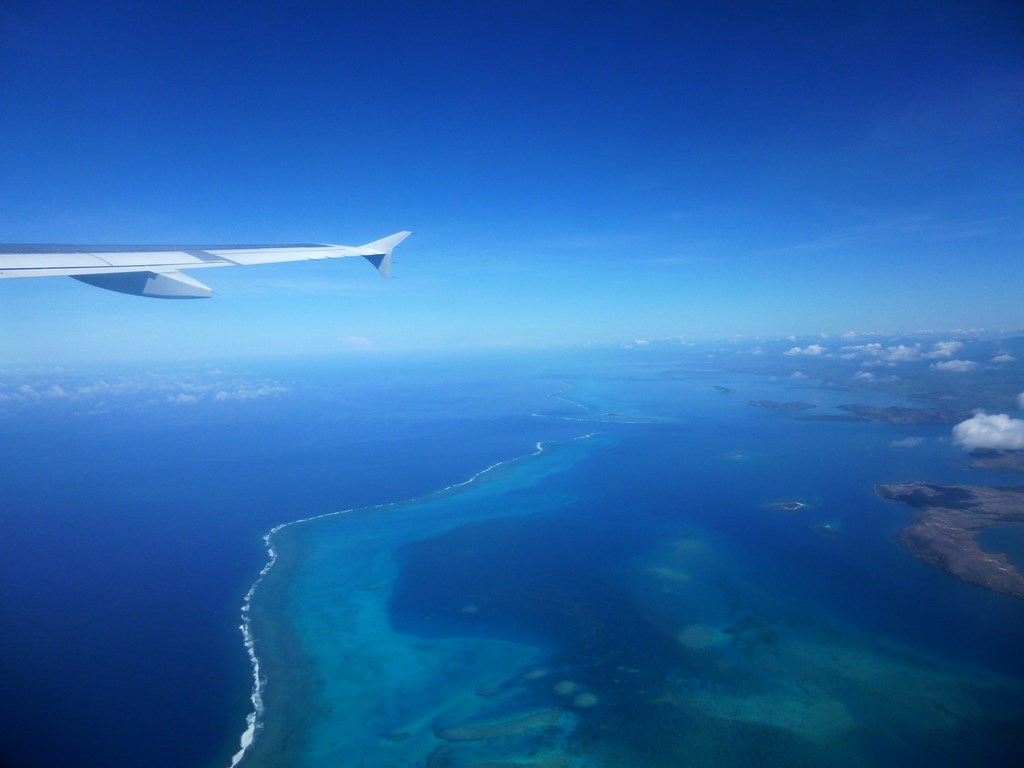LAGON CALEDONIEN VU DU CIEL
Les lagons de Nouvelle-Calédonie dans l'Océan Pacifique sont délimités par le plus long ensemble corallien continu du monde et à la seconde place en termes de superficie après la Grande barrière de corail le long de l'Australie.
La barrière, d'une longueur de 1 600 km délimite un lagon de 24 000 km², le plus grand du monde, d'une profondeur moyenne de 25 mètres, englobant l'archipel de la Grande Terre avec l'île principale de Grande Terre, les îles Belep, l'île des Pins et plusieurs îles et îlots de moindre taille. Elle est entrecoupée de passes qui font communiquer le lagon avec la haute mer.
Les récifs se trouvent en moyenne à 30 kilomètres de la côte, avec un maximum de 200 kilomètres aux récifs d'Entrecasteaux.
Ces lagons sont un lieu foisonnant de vie sous-marine. Riche et préservé, ils sont une merveille abritant plus 350 espèces de coraux et quelques 2500 espèces de poissons.
---------------------------------------------
The New Caledonia Barrier Reef is located in New Caledonia in the South Pacific, and is the second-longest double-barrier coral reef in the world, after the Belize Barrier Reef.
Ces lagons sont un lieu foisonnant de vie sous-marine. Riche et préservé, ils sont une merveille abritant plus 350 espèces de coraux et quelques 2500 espèces de poissons.
---------------------------------------------
The New Caledonia Barrier Reef is located in New Caledonia in the South Pacific, and is the second-longest double-barrier coral reef in the world, after the Belize Barrier Reef.
The New Caledonia Barrier reef surrounds Grande Terre, New Caledonia's largest island, as well as the Ile des Pins and several smaller islands, reaching a length of 1,500 kilometres (930 mi). The reef encloses a lagoon of 24,000 square kilometres (9,300 sq mi), which has an average depth of 25 meters (82 ft). The reefs lie up to 30 kilometres (19 mi) from the shore, but extend almost 200 kilometres (120 mi) to the Entrecasteaux reefs in the northwest. This northwestern extension encloses the Belep Islands and other sand cays. Several natural passages open out to the ocean. The Boulari passage, which leads to Noumea, the capital and chief port of New Caledonia, is marked by the Amédée lighthouse.
The reef has great species diversity with a high level of endemism, and is home to endangered dugongs (Dugong dugon), and is an important nesting site for green sea turtle (Chelonia mydas).
Most of the reefs are generally thought to be in good health. Some of the eastern reefs have been damaged by effluent from nickel mining on Grand Terre. Sedimentation from mining, agriculture, and grazing has affected reefs near river mouths, which has been worsened by the destruction of mangrove forests, which help to retain sediment. Some reefs have been buried under several metres of silt. In the lagoons of New Caledonia there are many water species ranging from plankton to larger fish and even sharks.
In January 2002, the French Government proposed listing New Caledonia's reefs as a UNESCO World Heritage Site. UNESCO listed New Caledonia Barrier Reef on the World Heritage List under the name The Lagoons of New Caledonia: Reef Diversity and Associated Ecosystems on 7 July 2008.
The Lagoons were listed under three UNESCO categories:
1. Superlative natural Phenomena or natural beauty.
2. Ongoing Biological and ecological processes.
3. Biological Diversity and threatened species.
